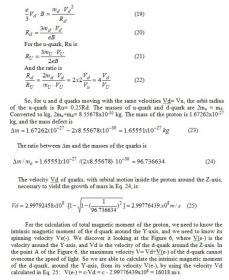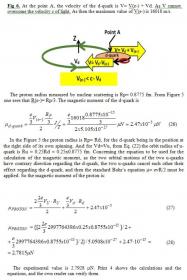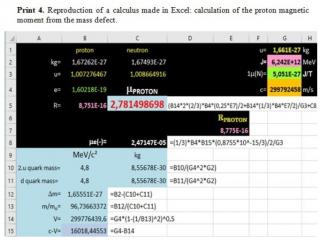In the book Subtle is the Math
are presented 16 papers,
among which a paper published in Physics Essays.
The calculation of the proton magnetic moment,
exposed ahead, belongs to the Paper Three (of the book) entitled
"Calculation of proton’s radius from the well-known equation α = Ke²/ħc".
are presented 16 papers,
among which a paper published in Physics Essays.
The calculation of the proton magnetic moment,
exposed ahead, belongs to the Paper Three (of the book) entitled
"Calculation of proton’s radius from the well-known equation α = Ke²/ħc".
5. Structure of the proton
Proton structure is at Figure 5. Gluons are not shown, because there is no need to consider them as contributors for the proton asymmetric structure (indispensable for the explanation of production of W boson in polarized beam of protons in scattering experiments) as will be shown. The down quark crosses orthogonally the magnetic lines of the magnetic field induced by the rotation of the two up quarks. As is known, when an electric charge is moving rectilinearly, but suddenly it enters in a magnetic field, in a way that it crosses orthogonally the lines of the field, the charge starts to move with circular motion. That’s why the down quark gets its orbital angular momentum inside the structure of the quark, L= m.v.R. The same happens with the up quarks, since they cross orthogonally the magnetic lines of the magnetic field induced by the down quark.
Fig 5. Structure of the proton, with the three quarks moving in circular trajectory around the Z-axis. Each u-quark is formed by one fermion of the quantum vacuum with charge +2e/3, and the d-quark is formed by one fermion with charge –e/3.
Analyzing the proton structure in the Figure 5, we note that:
a) At the top (inside the green rectangle) is shown that positive spin s=+½ of quarks has counter-clockwise rotation
b) Inside the big yellow down arrow, the spin of d-quark is due to its rotation around the Y-axis. The unity of positive spin s= +½ is due to the d-quark moving with counter-clockwise rotation (if d-quark would have clockwise rotation, its spin would be negative, s= -½).
c) Inside the structure of proton (blue sphere), d-quark has counter-clockwise orbital motion around the X-axis, and negative spin s= -½ around Y-axis. If it had positive spin s= +½, its contribution for the proton magnetic moment would be negative. But because it has s= -½, its contribution is positive.
d) Regarding up quark U1 and d-quark:
· Both them have orbital motion around the Z-axis in counter-clockwise direction.
· They have contrary spins
· So, if they had the same sign of charge, they would have tendency to cancel each other their magnetic moments.
· But as U1 has positive charge, and d-quark negative, both them contribute for a positive magnetic moment.
e) Up quarks U1 and U2 have contrary spins. Then:
· If they were moving in the same direction around the Z-axis, they would cancel each other their magnetic moments.
· But as they move in contrary direction, they add their contribution for a positive magnetic moment.
f) Therefore, all the three quarks contribute for a positive magnetic moment.
g) The two u-quarks have contrary spins, and contrary orbital angular momentum, and therefore they do not contribute for the total spin of the proton.
h) The d-quark has rotation with radius Re(-) around its own spinning center (Y-axis), and it with radius Rd= 2Re(-) around the Z-axis of the proton.
6. Calculation of the proton magnetic moment from the mass defect
The masses of the u and d quarks, measured by experiments, are respectively 2,3+0,7;-0,5 and 4,8+-,5;-0,3 MeV/c². Will be used 2.45 and 5.35 MeV/c².
As the two u-quarks cancel each other their contribution for the spin of the proton, there is no need to know what are the values of their orbital angular momentum. However, their orbital motions contribute for the magnetic moment, and so there is need to know what is the value of their orbital radius Ru. This is calculated ahead.
The equilibrium between the magnetic and centrifugal forces on the d-quark is given by:
via International Skeptics Forum https://ift.tt/3cRueRw




Aucun commentaire:
Enregistrer un commentaire